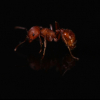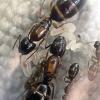Barely into hibernation one week and what do I see when I glance into the cooler today? (glass doors are great for idle checks) One or two small workers roaming around the cooler. Unusual, but not the first time, I originally figured it was one of the extra Camponotus herculeanus colonies that were about due to come out. They sometimes slip out if the lid isn't on tight in the one type of container. I ignored them, hoping they would eventually hang out on the cotton plugging the test tube that they belonged to. Terrible to stick them into the wrong colony, and I have 7 or 8 of that species in hibernation right now, most with under 10 workers.
I came back later that evening to see more ants out - including several huge majors. That is not good, majors can't squeeze out of anything. And I have only one colony with majors that large - this colony.
I grabbed my trusty featherweight tweezers and a dusted escape proof bin and grabbed every loose worker I saw in the cooler - 12 in total. Carefully pulled out the nest to see that they chewed through a 3/4" cotton plug in the main entrance. Removed the now-useless cotton and quickly replaced it with a new cotton ball.
Do you need to get by entrance guards to stuff 10 workers inside a piece of tubing? Distract them - throw in a 3/4 dead mealworm. It keeps most of them busy. I managed to get them all inside the tubing without incident and plugged the entrance behind them.
I found a small test tube that just barely fit over the tubing and filled it 1/4 full of hummingbird nectar. Quickly removed the cotton and capped the tubing with the test tube, leaving about 1/2" of room in front of the test tube cotton for turn around room. They may chew threw cotton, but not through glass or vinyl tubing. Now they can get snacks and cannot escape.
I will have to make a mental note to do this for all larger colonies... I did it last year for most colonies in case they ran out of reserves, they had so many fat workers this year I wasn't worried and didn't cap the tubing with test tubes. Lesson learnt.
Now I just hope they don't realize that the side entrance is only plugged with cotton, although I only use that entrance to move the colony and they have never chewed on it. I doubt they even realize that it is a potential exit.






























